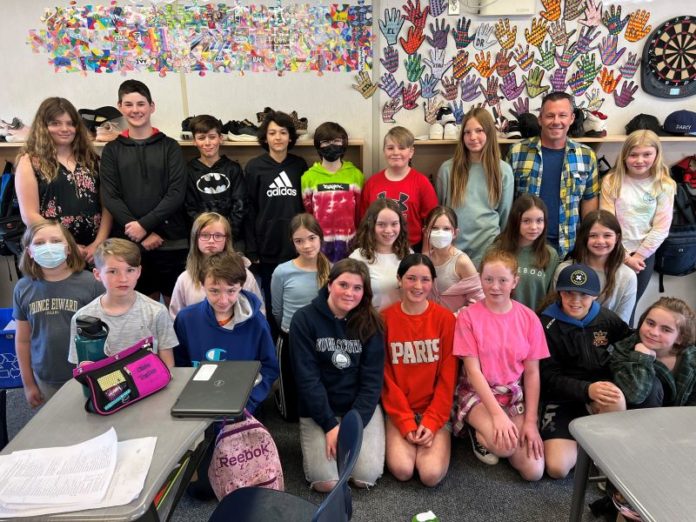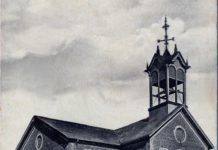submitted by UCDSB
A class at Kemptville Public School is currently working on a very interesting history project – the Hill 70 Project. In fact, Mr. Robert Lachance’s grade 6 class is the ONLY elementary grade working on this project that is also seeing 18 other high school classes participating across the Upper Canada District School Board. Mr. Lachance shared some information about the project with the Times.
Hill 70 is often called “Canada’s Forgotten Battle”. It took place between August 15-25 in 1917, just north of the mining town of Lens in France. It happened after Vimy and happened just as the Passchendaele offensive was beginning. The battle of Hill 70 was the first time that Canadians were fighting under a full Canadian command. Its purpose was to take pressure off the Allied push at Passchendaele by diverting German divisions to Lens.
Last spring, construction began on a new hospital in the northern sector of Loos in France, just south of Hill 70. The excavation of the area produced a number of bodies that belonged to unidentified Canadian soldiers who fought in this battle. In total, 120 bodies were found (so far). Each one of these soldiers who were found have been considered “missing in action” since their disappearance, as these bodies were never recovered, identified and properly buried by our armed forces. The federal government, in cooperation with the Canadian Armed Forces as well as a number of outside agencies and universities, is currently working with the Canadian Casualty Identification Program led by forensic anthropologist Doctor Sarah Lockyer to determine who these men were in order to finally give them an appropriate burial and bring their families peace and closure. This is where the Upper Canada District School Board – and Mr. Lachance’s students get involved.
Historians have worked hard to determine which unit these soldiers would have come from. Given the location of the bodies and after the appropriate correlation of coordinates using period maps, we now know that the Canadians in this sector were from the 10th Battalion. Mr. Lachance has tasked his students with researching soldiers from the 10th Battalion who died and were lost and never found during the battle of Hill 70.
Mr. Lachance decided to get his younger students involved in this because he has a lot of previous experience in accessing WW1 Canadian records. He has shown the class how to access the required information through the National Library of Canada, and he has helped them to properly understand what it is they are reading, although it is not always easy. The class has entered this data into a specific database that the anthropologists will use to access specific information that in turn may prove useful in the identification of the fallen soldier.
This is a wonderful learning opportunity for these KPS students who are very excited to be a part of this large project. The records that the students have been looking at have remained untouched since the end of WW1. They are likely the first to see and study these attestation papers since they were filed away over 100 years ago. For the class, knowing that in some small way they may be able to facilitate and contribute to the identification of a lost Canadian soldier is very gratifying and provides the students with a huge buy-in.
Many of the soldiers who fought at Hill 70 came from the communities surrounding North Grenville. In fact, the names of two men who died in the opening days of that battle are listed on the Kemptville cenotaph, and there is also a Hill 70 monument located in Mountain, about 15 minutes from Kemptville. The only other Hill 70 monument is located on Hill 70 itself. During the battle, Canadian soldiers endured 21 counterattacks that were repelled before the fighting eventually ended. In total, Canada suffered close to 9,000 casualties in this 10-day battle.
What is happening with Mr. Lachance’s class at KPS is an authentic “real world” learning experience for the students. “It is really cool to be involved in such a noble cause and I can see how my students are learning to appreciate Canadian history and recognize how our past has shaped our present-day society,” added Mr. Lachance.
The class is nearing the end of the unit as June is quickly approaching, but Mr. Lachance hopes to be able to continue to help the Hill 70 project next year. He is also very honoured and humbled to have been nominated this year for the Governor General’s Award in Teaching Excellence for his continued efforts in teaching his students the importance of remembering and honouring Canadian soldiers – both past and present. During Mr. Lachance’s teaching career, he has taken his students to the Kemptville cenotaph every year for the past 20 years (except during COVID). At the end of the ceremony, they are tasked with delivering poppies of thanks to retired and currently serving members of the Canadian Forces. That is a very powerful moment every year. Mr. Lachance believes that it is important for the students not only to learn about our past military commitments, but also to see the impact they have in our community.








